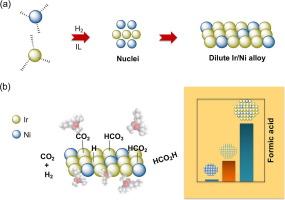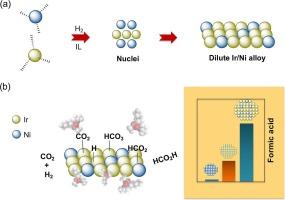Unlocking dynamic intermetallic synergy: Ir/Ni alloy nanoparticles catalyze CO2 hydrogenation to formic acid in ionic liquid environments
IF 6.5
1区 化学
Q2 CHEMISTRY, PHYSICAL
引用次数: 0
Abstract
The Bimetallic Ir/Ni alloy nanoparticles (∼2.0 nm) are prepared in 1-n-butyl-3-methylimidazolium bis(trifluoromethanesulfonyl)imide (BMIm.NTf2) ionic liquid, which have a unique architecture, featuring an Ir-rich alloy core surrounded by a Ni-rich alloy. The prepared bimetallic NPs exhibited efficient activity for the hydrogenation of CO2 to formic acid (1.02 M) with TOFs of 151.7 h−1 as compared to their counterparts; Ir NPs (TOF 38.5 h−1) and Ni NPs (TOF 0) in 1-n-butyl-3-methylimidazolium acetate (BMIm.OAc) IL solutions. This synergistic metal dilution effect arises from the inter-particle heterogeneities present in our Ir/Ni alloy NPs, causing alterations in surface structure and composition with an increase in the number of d-band holes. It offers a diverse population of active sites and tunes the adsorbate migration between reactive intermediates. The BMIm.OAc IL representes multifunctional roles, acting as a buffer and creating an IL-solvent cage around the NPs, reactants, and reactive intermediates. This alters the entropy by increasing the number of microstates, overcoming thermodynamic limitations. The synchrotron X-ray photoelectron spectroscopy and soft-XANES analyses reveal that the Ir/Ni NPs have variable electron density, the NPs surface have lower electron density than those at inner regions, which enhance the number of valence vacancies. The dilution of iridium with nickel in our Ir/Ni NPs attributes the abundance of d-band holes and O-p holes to the high oxidation state at the surface, and increases the presence of lattice vacancies. These distinct characteristics of NPs significantly boost the FA formation as compared to their counterparts. DFT calculations confirmed that the formation of FA follows the hydrogenation of HCO3* reactive intermediates.


释放金属间的动态协同作用:Ir/Ni 合金纳米颗粒在离子液体环境中催化 CO2 加氢生成甲酸
在 1-n-butyl-3-methylimidazolium bis(trifluoromethanesulfonyl)imide (BMIm.NTf2)离子液体中制备了 Ir/Ni 双金属合金纳米粒子(∼2.0 nm),它具有独特的结构,富含 Ir 的合金核心被富含 Ni- 的合金所包围。制备的双金属 NPs 在 1-n-butyl-3-methylimidazolium acetate (BMIm.OAc) IL 溶液中将 CO2 加氢为甲酸(1.02 M)的过程中表现出高效的活性,其 TOF 值为 151.7 h-1,而其对应的 Ir NPs(TOF 值为 38.5 h-1)和 Ni NPs(TOF 值为 0)的 TOF 值为 0。这种协同金属稀释效应源于我们的 Ir/Ni 合金 NPs 中存在的粒子间异质性,它随着 d 带孔数量的增加而改变了表面结构和组成。它提供了多样化的活性位点,并调整了反应中间体之间的吸附迁移。BMIm.OAc IL 具有多种功能,既是缓冲剂,又能在 NPs、反应物和反应中间体周围形成一个 IL 溶剂笼。这通过增加微观状态的数量改变了熵,克服了热力学限制。同步辐射 X 射线光电子能谱和软 XANES 分析表明,铱/镍 NPs 具有不同的电子密度,NPs 表面的电子密度低于内部区域,从而增加了价位空位的数量。在我们的 Ir/Ni NPs 中,铱与镍的稀释使表面的高氧化态产生了大量的 d 波段空穴和 O-p 波段空穴,并增加了晶格空位的存在。与同类产品相比,NPs 的这些显著特点大大促进了 FA 的形成。DFT 计算证实,FA 是在 HCO3* 反应中间产物氢化之后形成的。
本文章由计算机程序翻译,如有差异,请以英文原文为准。
求助全文
约1分钟内获得全文
求助全文
来源期刊

Journal of Catalysis
工程技术-工程:化工
CiteScore
12.30
自引率
5.50%
发文量
447
审稿时长
31 days
期刊介绍:
The Journal of Catalysis publishes scholarly articles on both heterogeneous and homogeneous catalysis, covering a wide range of chemical transformations. These include various types of catalysis, such as those mediated by photons, plasmons, and electrons. The focus of the studies is to understand the relationship between catalytic function and the underlying chemical properties of surfaces and metal complexes.
The articles in the journal offer innovative concepts and explore the synthesis and kinetics of inorganic solids and homogeneous complexes. Furthermore, they discuss spectroscopic techniques for characterizing catalysts, investigate the interaction of probes and reacting species with catalysts, and employ theoretical methods.
The research presented in the journal should have direct relevance to the field of catalytic processes, addressing either fundamental aspects or applications of catalysis.
 求助内容:
求助内容: 应助结果提醒方式:
应助结果提醒方式:


